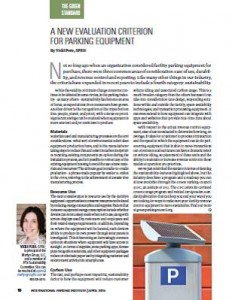Not so long ago when an organization considered facility parking equipment for purchase, there were three common areas of consideration: ease of use, durability, and revenue control and reporting. Like many other things in our industry, the criteria have expanded in recent years to include a fourth category: sustainability.
While the validity of climate change concerns continue to be debated in some circles, in the parking industry—as many others—sustainability has become an area of focus, as expectations from consumers have grown. Another driver is the recognition of the triple bottom line: people, planet, and profit, with a focus on profit. Significant savings can be realized when equipment is more efficient and/or costs less to produce.
Materials
Materials used and manufacturing processes are the first considerations. What sort of environmental effect does equipment production have, and is the manufacturer taking steps to reduce this and offset its carbon footprint? Is recycling existing components an option during the installation process, and is it possible to retrofit any of the existing equipment housing to avoid the use of new materials and resources? The ultimate goal is cradle-to-cradle production—a phrase made popular by Walter R. Stahel in the 1970s, referring to the achievement of a waste-free manufacturing process.
Resource Use
The next consideration is resource use by the facility’s equipment. Opportunities to conserve resources can be found by reducing energy consumption and supplies. Factors that influence equipment energy consumption include whether devices can enter a sleep mode when not in use, along with screen displays used by customers and employees and their related energy requirements. In addition, depending on where the equipment will be located, each device’s ability to produce its own power through solar panels is investigated. This is becoming an increasingly common option in situations where equipment will have access to sunlight. In terms of supplies, some parking apps, license plate recognition solutions, and other equipment packages reduce or eliminate paper use by integrating customer and enforcement activity into smartphones.
Carbon Use
The last, and perhaps most impactful, sustainability factor is how the equipment will reduce customer vehicle idling and associated carbon usage. This is a much broader category than the others because it can take into consideration lane design, wayfinding solutions within and outside the facility, space availability technologies, and transaction processing equipment. It can even extend to how equipment can integrate with apps and websites that provide real-time data about space availability.
With respect to the actual revenue control equipment, ease of use is evaluated to determine how long, on average, it takes for a customer to process a transaction and the speed at which the equipment can do its part. Sourcing equipment that is able to move transactions out of entrance and exit lanes can have a dramatic effect on vehicle idling, so placement of these units and the ability to maintain or increase revenue control in these modes of operation are priorities.
We’ve just scratched the surface in terms of defining the sustainability features highlighted above, but the industry does have a program and a roadmap you can follow available through the Green Parking Council (GPC, an affiliate of IPI). The GPC offers its Certified Green Garage program and related Certification Standard publication that can help you find your way if you are looking for ways to make sure your facility revenue control equipment is more sustainable. Find out more at greenparkingcouncil.org.
Vicki Pero, SPRH, is principal of the Marlyn Group, LLC, and a member of IPI’s Sustainability Committee. She can be reached at vpero@marlyngroupllc.com or 800.825.6310.
TPP-2015-04-A New Evaluation Criterion For Parking Equipment

